|
The most popular tourist spots that are counted among the must see 'places of tourist interest' in Jaipur in Rajasthan, India are the Amber Fort, Jaigarh Fort, Jantar Mantar Hawa Mahal, Chandra Mahal, Albert Museum, Kanak Vrindavan, Laxmi Narayan Temple, Galtaji Temple Complex, Govind Devji Temple, Cenotaphs of Gaitore, Isar Lat and the Raj Mahal Palace.
Jal Mahal
We still think of building castles in the air, they built it inside water, myriad years earlier. Amidst the shimmering green waters of Man Sagar Lake, this architectural prodigy poses as a gigantic iceberg, ready to knock another Titanic, off its pedestals. Built as a pleasure palace for the imperial family, the palace is known for its magnificent architecture and erudite design. During winter months one can see large number of migratory birds at the lake. Flanked by Nahargarh Hills on all sides, the palace was once used for regal duck shooting parties. Enjoy a stay in the Jal Mahal Palace in Jaipur.
|
|
The City Palace
One of the most magnificent marvels or Jaipur is the City
Palace Complex which has a rare combination of the finest
blends of Rajasthani and Mughal architecture. In the heart of
the old city, it has vast area. The outer wall was built by
Jai Singh and additions made up to the 20th century. Many
buildings, well-planned gardens and huge courtyards are a part
of the complex. For visiting dignitaries, Sawai Madho Singh
II, constructed Mubarak Mahal (welcome palace) as a reception
centre. The mahal comes before the main complex, though it now
forms a part of the Maharaja Sawai Man Singh II Museum. The
museum has an array of royal costumes, shawls, embroideries,
Benares silk sarees, the maharaja's pyjamas, chogas and
pyjamas of other rulers, jamawars, kamarbands, musical
instruments like the giant sized tanpura and sarangis and a
set of the clothes of Sawai Madho Singh I who was just over
seven feet tall, over four feet wide and supported a Goliathic
weight of 250 kilograms.
A delight is the Maharani's Palace, now the armory with arms
to the 15th century which include the deadly Rajput
scissor-action daggers which have a unique working action
(after the dagger entered the body, the handles were released
and the blades spread. during withdrawal, killing the victim).
The guns include the ones that also served as walking sticks,
one of the size of a small canon fired from a camel's back,
double-barrel guns, early handguns, matchlocks and percussion
cap guns, swords with pistols attached to the blades, daggers
with handles of crystal and invory, katars, chhuris, peak-kubz
jambhiya, Persian and Rajput swords. Deccan hand, bows and
arrows, battle axes, shields, maces, breast and shoulder plate
gutzis and the ruby and emerald encrusted sword presented by
Queen Vicoria to Maharaja Sawai Ram Singh (1835-1880). On
display are a big range of shields of rhino, crocodile and
turtle skin, the shield of Sawai Pratap Singh and Raja Man
Singh' sword weighing about 5 kilograms.
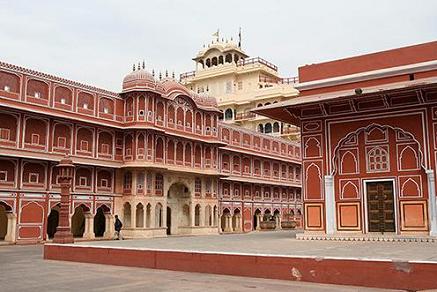
Diwan-e-Khas (hall of private audience) is housed between the
art gallery (once the diwan-e-aam-hall of public audience) and
the armoury. The most attractive feature are the two sterling
silver vessels (in the marble-paved gallery) in which Maharaja
Madho Singh II, a devout Hindu, took holy Ganga water during a
visit to Europe. The two vessels are massive standing 160 cm
and have a capacity of 9000 litres each. They are listed in
the Guinness book of Records as the biggest silver vessels in
the world. From the ceiling of the hall hang a number of
chandeliers which are covered with plastic to prevent dust and
bird droppings falling on them.
The art gallery in the erstwhile Diwan-e-aam has a well
preserved painted ceiling on which the original semi-precious
stones still retain their lustre. Suspended from the ceiling
is a massive chandelier made of crystal. The art gallery also
has miniature paintings of the Rajasthani, Mughal and Persian
schools featuring religious them mainly scenes from the
Ramayana. The other exhibits include an unbraided, handwritten
version of the Bhagaved Gita, miniature copies of other holy
Hindu scriptures, handwritten books in Persian and Sanskrit
and early manuscripts on palmleaes There are among the 20,000
manuscripts that the museum boasts of. Howdahs (elephant
saddles), palanquins, the swing of Lord Krishna and paper
cuttings cut with the thumbnails are among the several other
exhibits in the gallery. One can also see the finest carpets
from Herat in Afghanistan and Lahore.
Chandra Mahal is the only part of the complex that is
inhabited and is occupied by the royal family. The ground
floor of the palace, open to visitors, has some exhibits. In
the courtyard outside is the elegantly designed Peacock Gate.
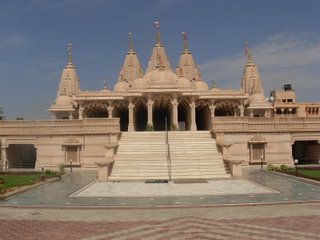
Govindji Temple
The city place complex also houses the Govindji Temple and is
a temple of Lord krishna and Large number of people visit it.
The temple was built in such a fashion that the king could see
the deity from the Chandra Mahal, opposite it. The temple is
surrounded by gardens and palaces. The image of Govind Devji
was originally installed in a temple in Vrindavan.
Jantar Mantar
Jantar Mantar is the largest and best preserved of Sawai Jai
Singh's five observatories. It is built in stone and marble
whose setting and shapes are designed scientifically and which
are one of the high points of medieval highpoints of medieval
Indian astronomy. There are also two Ram Yantras for gauging
altitudes. Timings : 9:30 a.m. to 4:30 p.m.
Hawa Hahal The palace of winds
The palace of winds a fascinating landmark of Rajasthan, was
built by the orders of poet-king, Sawai Pratap Singh in the
18th century and is the most remarkably designed monument in
Jaipur. What is seen from the Sireh Deorhi Bazar is the Multi-niched
five storey high backside of the complex. it was conceived to
provide adequate vantage position behind stone carved mesh
like screens to the palace women for watching the royal
processions passing through the bazaar. It now has a museum
and the collections include paintings, coins, handicrafts and
sculptures. 'Jaipur-past and present' is the special feature
of the museum.
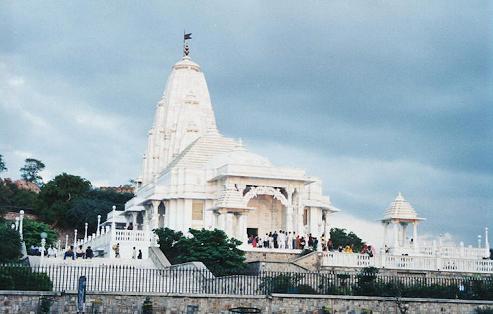 Moti Doongari and Lakshmi Narayan Temple
Moti Doongari and Lakshmi Narayan Temple
Among the important landmarks dotting the southern horizon is
the small privately owned hilltop fort of Moti Doongari which
is shaped like a Scottish castle, the Ganesh Temple at the
foot of the hill and the marble built Lakshmi Narayan Temple.
Jagat Shiromani Temple
The beautifully carved Jagat Shiromani Temple houses the idol
of Lord Krishna and is popularly associated with the
celebrated saint poetess Mira Bai. The old temple of
Narsinghji and a step well Panna Mianki-Baodi, which still
bears witness to its past glory are also located in the
vicinity.
Jaigarh Fort
The western skyline is dominated by the extensive parkotas
(walls), watch towers and gateways of Jaigarh. It is one of
the few military structures of mediaeval India preserved
almost intact containing palaces, gardens, open and covered
reservoirs, a granary, an armory, a well planned cannon
foundry, several temples, a tall tower and a giant mounted
cannon the Jai Ban one of the giggest in the World.
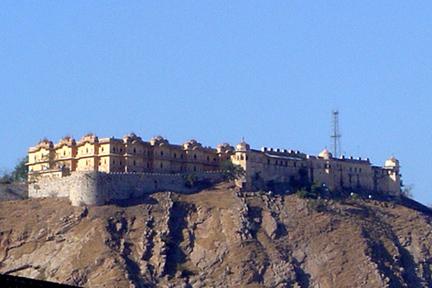 Nahargarh Fort
Nahargarh Fort
It is 15 kilometers from Jaipur beyond the hills of Jaigarh
and is like a watchful sentinel guarding Sawai Jai Singh's
beautiful capital. Much of the original structures are in
ruins. From atop a hill, the fort offers a scenic view of the
city be low. Rajasthan Tourism has started a cafeteria where
Beer and snacks are available from 10 a.m. to 10 p.m.
Jal Mahal
Jal Mahal was built by Sawai Pratap Shing in 1799 A.D. in the
midst of the Man Sagar Lake as a pleasure spot. The Lake was
formed by constructing a dam between the two hills by Sawai
Man Singh I. During winter months one can see a large number
of migratory birds at the lake.
Amber Palace and Fort complex
Situated just over 10 kilometres away from Jaipur on the
Jaipur-Delhi highway is Amber, which was the ancient capital
of Jaipur State. A bus leaves from Hawa Mahal every 30 minutes
and a well-laid out road takes the visitor out of the city and
very soon one witnesses lush green hills.
One then notices a lake and standing next to it is the
majestic Amber Fort which several rulers of the erstwhile
State of Jaipur recognized as a vantage military building. The
excursion start of Jaipur recognized as a vantage military
building. The excursion starts with the Dil-E-Aaram Garden
which is laid out in the traditional Mughal style. The complex
of palaces, halls, pavilions, gardens and temples was built by
Raja Man Singh, The Rajput commander of Akbar's Army, Mirza
Raja Jai Singh an Sawai Jai Singh, over a period of about two
centuries. One can climb up to the fort from the road in about
10 minutes, go up by a jeep or even on elephant back. The
diwan-E-aam (hall of public audience) has latticed galleries
and double row of columns each having a capital in the shape
of elephants on the top. To the right are steps that lead to
the Kali Temple where everyday a goat was sacrificed right up
to 1980 when the practice was banned by the state government.
The temple offers a wonderful sight and has huge doors made of
silver. It is said that Maharaja Man Singh prayed to the
goddess for victory during a particular battle. The goddess
was said to have come in his dream and said that if he won the
battle, then he should retriever her image which was lying at
the bottom of the sea. he won the battle, retrieved the image
and installed it at the temple of Shitla Devi.
Swarghashuli/Isar Lat
The tower on the western side of Tripolia Bazaar is the
highest structure in Jaipur and was builr by Sawai Ishwari
singh in 1749 to commemorate an important victory.
Ram Niwas Bagh
To provide open space and greenery to the citizens, there is a
big garden, with a zoo, an aviary, a greenhouse, a herbarium,
a museum and several sports grounds. It was built during the
reign of Sawai Ram Singh II' in 1868 as a famine relief
project.
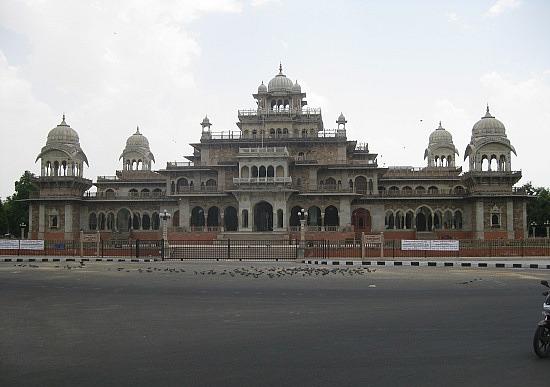 Albert Hall
Albert Hall
It is situated in the beautiful Ram Niwas Garden. This
beautifully designed Saracenic structure was designed by sir
Swinton Jacob. It was opened in 1887 as a public museum. It
contains a rare collection of decorative art objects,
paintings, sculptures, natural history specimens, an Egyptian
Mummy and the well known Persian Golden Carpet.
Dolls Museum
Located near the Police memorial towards the back side of SMS
Hospital is the Dolls Museum. There are attractive dolls from
various countries and is housed in the compound of the school
for the deaf and the dumb.
Sisodia Rani Garden
It is eight kilometres away from Jaipur on the road to Agra.
Several landscaped gardens were constructed by the kings and
the courtiers in the 18th and 19th centuries with the biggest
and the most famouse being one built by Sawai Jai Singh for
his Sisodia queen, the Sisodia Rani Ka Bagh. It consists of
tiered multilevel gardens with fountains, watercourses and
painted pavilions.
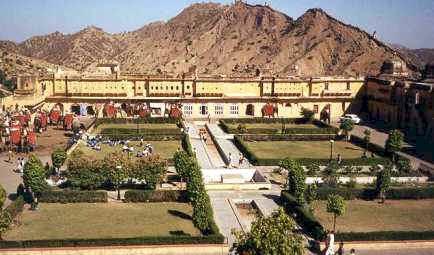 Vidyadhar Garden
Vidyadhar Garden
This garden is named after Vidyadhar who was the chief
architect and town planner of Sawai Jai Singh II. It falls
just before the Sisodia Garden and the gardens have been
planned in the medieval style. Every evening. lights concealed
at the base of the surrounding hills lighten up the place.
Statue Circle
The full length white marble statue of Sawai Jai Singh
installed in the centre of the circle in the newly developed
C-Scheme area was erected as a tribute to the founder of
Jaipur.
Gaitore
Eight kilometres on the road to Amer, it has memorials of
queens in the Maharani-ki-Chhatri complex near the Ramgarh
road crossing, the island palace - Jai Mahal built by Sawai
Madho Singh as a pleasure spot at the Man sagar lake and the
Kanak Vrindavan complex temples and gardens recently
renovated. To the west, in a narrow valley, is the royal
cremation ground and the cenotaphs of Jaipur rulers with the
exception of Sawai Ishwari Singh, who was cremated outside the
Jai Niwas Garden.
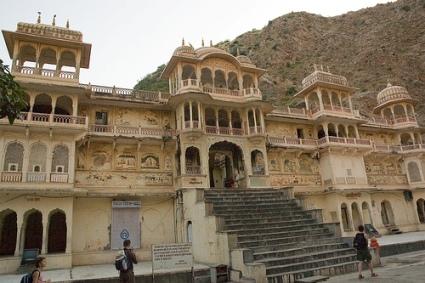 Galta
Galta
In the vicinity of the city, 10 kms. from Jaipur, Galta is
situated amidst the range of hills east of the city. On the
top of the hill. overlooking the Galta valler is a sun temple.
To the east of the temple is a reservoir or a tank which is
fed by spring of pure water falling from a Gaumukh or an
outlet shaped like the mouth of a cow. On way to Galta, by the
Ghat-ki-Guni, is a range of hills crowned with the fort of
Amargarh.
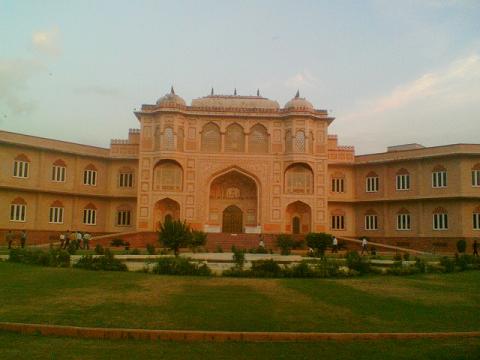 Birla Planetarium
Birla Planetarium
The planetarium is on the Statue Circe and is made of white
marble. One can get a view of the cosmos with the production
and sound system of the planetarium
Birla Auditorium and Convention Centre
Over 9.5 acres, it houses a museum, auditorium, (with a
seating capacity of 1,300), a library, a planetarium and a big
exhibition area. The convention centre hosts major
conferences. The entrance facade is a replica of Ganesh Pole
of Amber Palace. |

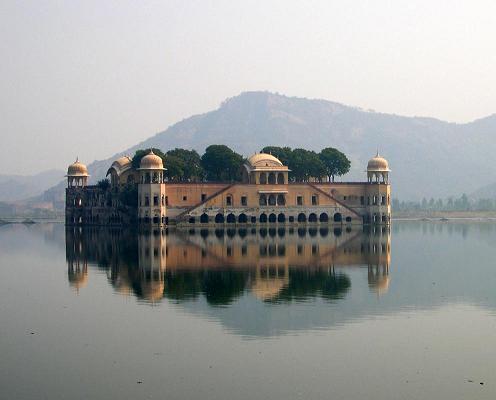


 Moti Doongari and Lakshmi Narayan Temple
Moti Doongari and Lakshmi Narayan Temple Nahargarh Fort
Nahargarh Fort Albert Hall
Albert Hall Vidyadhar Garden
Vidyadhar Garden Galta
Galta Birla Planetarium
Birla Planetarium